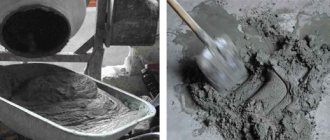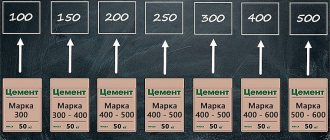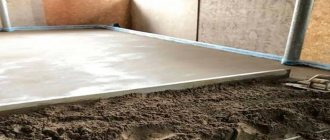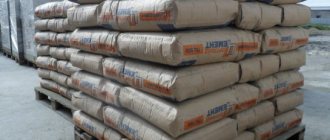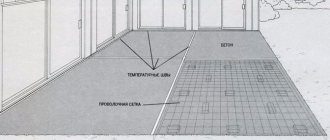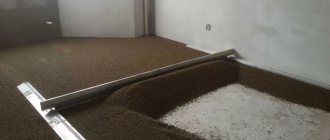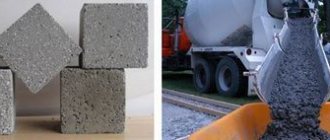This is the name given to the mixture prepared at the factory and intended for delivery to the site. It is used for a wide range of work:
- construction of foundations;
- road construction;
- creation of large transport interchanges;
- bridge construction;
- production of various structural elements;
- construction of swimming pools and special tanks;
- construction of houses using monolithic technology.
Liquid concrete
is not the only type of solution.
There are also hard formulations, as well as dry mixtures. The high mobility of the substance made it possible to use it to create entire residential complexes. The pouring method is quite simple and compares favorably with construction technology using FBS due to its low labor intensity. Liquid concrete
is supplied directly to the work site directly from an ABS tray or using a concrete pump; blocks, in turn, require the involvement of a crane, and often more than one.
Due to the relative simplicity of the pouring operation, all modern private houses are built on foundations made using monolithic technology. It is the low labor intensity that attracts people who build their own homes. Moreover, liquid concrete allows you to get any shape of the base, which frees up the customer’s hands when choosing an architectural project. Yes, the process of pouring the solution itself requires the supervision of a specialist, since unscrupulous workers may try to violate the technology. From the point of view of members of seasonal construction teams, it does not matter what characteristics the mixture has in the formwork. They just need to quickly complete the preparation of the base with minimal labor costs. In some cases, there may be a loss of concrete grade after dilution with water
.
This fact is an indicator of the low qualifications of the team, therefore, if there is no possibility of personal control, then it is better to involve professionals in the matter. Of course, liquid concrete
is not so difficult, but it often requires feeding it through trays, which requires some effort.
Specialists, unlike seasonal players, will be able to solve this problem without losing the characteristics of the composition. A beginner in construction is often faced with the question of sampling to check the quality of the mixture, but this is relatively easy. On the other hand, those who know how to make concrete correctly
may encounter a number of problems that await an inexperienced person. There are a lot of them, but even having avoided most of the difficult moments, the novice builder finds out that it would be cheaper to order the mixture at the factory than to do it yourself.
General characteristics
Communicating with professionals and simply plunging into the topic, it turns out that almost everywhere an abbreviation is used - concrete is designated by an alphanumeric index:
- M – grade, where the numbers indicate the average compressive strength in kg per cm², before failure begins.
- B is its class, a more modern designation. Similar to a brand, but its meaning is guaranteed strength with a safety factor.
- P – mobility. Characterization is important to ensure the quality of work. Simple monolithic work is carried out with low-mobility concrete - in common parlance the process is called “laying”. And narrow, densely reinforced structures, difficult to reach with a vibrator and “bayonet” the cavity, require high mobility material for “filling”.
- F – hardness. Characteristics of “lean” concrete – with a reduced amount of cement and water. These proportions of concrete for the foundation are well suited for its lowest part - to close the cushion. Because there is no “excess water” to react with the cement, rigid concrete suffers less from shrinkage. It is also actively used for road construction.
- W – waterproof. Achieved with special additives. Tangible advantages: operation without additional waterproofing, no negative consequences from seasonal frosts and thaws.
- F – frost resistance. Value – the number of freeze-thaw cycles without loss, or with an acceptable change in strength.
Components
A mixture of four main components, each of them has its own tasks. Sometimes additives are present. Let's study them to figure out how to make concrete correctly.
Binders
Cement and water are the main reagents that bind all components into a single monolith. The grade of concrete directly depends on the brand and amount of cement. Even after accidental interaction with water, the cement sets and hardens into stone. It would seem that the result has been achieved. However, the technical characteristics are far from desirable. They are significantly increased by the use of fillers.
Fillers
Ideally, in a concrete mixture, a large filler - crushed stone - is supplemented with a medium - smaller size. And the free space between them is filled with fine filler - sand. This is an optimal structure that can reduce shrinkage, increase strength many times over, but at the same time significantly reduce the cost of the final product, for example, the foundation of a house. Since we are talking about the conditions for large-scale work, the proportions of concrete for the foundation in buckets is the most easy-to-understand formulation.
For an improved result, it is desirable that the strength of the filler is approximately 2 times higher than the design strength of concrete. After all, it accumulates after 28 days and grows over time. At the same time, the strength of the filler itself remains the same. And this approach more or less equalizes the difference between it and the binder. This results in a safety margin at an optimal cost.
Main types of crushed stone:
- Limestone. With some types it is possible to obtain fairly strong concrete. But low moisture resistance and frost resistance limits the scope of application. It feels good in a space protected from precipitation, and even better in heated rooms. On the street, such material deteriorates relatively quickly.
- Gravel. The most popular filler in individual construction. Its strength is more than sufficient, it is much easier to work with, and the cost is low. Therefore, there is a rather controversial opinion that the most correct do-it-yourself concrete is based on gravel.
- Granite. Durable filler with low water absorption and high frost resistance.
Chemical additives
Specific properties necessary for certain conditions are given to concrete by additives - plasticizers and modifiers:
- The plasticizing additive increases the mobility of the mixture, so you need a little less water for mixing. Consequently, the design strength is achieved with less cement - this is a saving. However, additives affect the hardening time and initial strength development.
- Antifreeze additives are not cheap. The price of a dosage that allows working down to -20 °C is comparable to the price of concrete itself. At sub-zero temperatures, after 28 days it must gain at least 30% of its design strength. The rest will pick up quickly enough at above-zero temperatures.
Important: how to mix concrete correctly without expensive chemical additives? In everyday life, any concentrated soap solution works well as a plasticizer. PVA glue increases strength, and liquid glass waterproofing properties. If concreting at a slightly negative temperature is vital, you can add table salt. But this is “at your own peril and risk”, a small volume in an inappropriate place. Having prepared mentally and understanding that we will lose some of our strength. A high-quality alternative is a heating device.
Under normal conditions - 15-20 °C, in 3 days the concrete will strengthen by approximately 30% of the design strength, in 7 days - by 70%, after 28 days it will be 100%. As the temperature decreases, the dynamics of strength gain decreases. Of course, he will gain full strength, but this period will drag on.
Useful tips
Here are some helpful tips to help you with your concrete mixing work.
- It is necessary to work with the material until it begins to set. In the warm season, at a temperature of 20 - 23 o C, concrete begins to harden approximately 1.5 - 2 hours after preparation.
- If you don’t have a ready-made container for mixing or emptying the concrete mixer, you can make one yourself. An improvised “trough” made of boards is enough. It should be taken into account that upon completion of the work the wood will most likely become unusable. Therefore, to create a container, it is better to use a material that is not a pity.
- Cement should not be stored for too long. Over time, the material loses its properties - it grips worse and begins to clump heavily. Therefore, before purchasing, you should pay attention to the date of manufacture.
- Washed sand is best suited for the job. However, it is more expensive. However, you can get it at the regular price. Sand is often extracted from bodies of water - lakes or rivers. When extracted from water, most of the foreign impurities are washed out. There is absolutely no dust in this sand. Therefore, if possible, preference should be given to him.
- After mixing, the solution must be properly compacted. This is done by compacting with a shovel or other tool. Compaction allows you to remove air bubbles from the solution and thereby make it stronger.
How to mix - proportions
Not only the brand of cement affects the class of the final product, but also the proportions of the components. As an example, the same proportions of cement for concrete are used, but the proportions of filler change. And in this way you can get concrete of various grades:
- m250. For 1 bucket of cement there are 2 buckets of sand, 4.5 buckets of crushed stone;
- m350. For 1 bucket of cement you need to take 1.5 buckets of sand, 4 buckets of crushed stone;
- m450. For 1 bucket of cement – 1 bucket of sand, 3 buckets of crushed stone.
The example is convenient because the proportions of concrete are in buckets. Everything can be repeated - there is no need to convert mass values into volumes.
To make concrete with your own hands, gravel is often used. The cheapest material is most accessible immediately after extraction - a sand-gravel mixture. Which is convenient in principle - large and small fillers are purchased at once. However, it is not always practical - their proportions cannot be changed. It doesn’t matter, if there is more of the coarse fraction, you can simply add the fine one. But if there is noticeably more sand, sifting out even part of it is a very labor-intensive task.
Usually, time-tested proportions are practiced: 1 part of cement and water are added to 6-7 parts of gravel “by eye”. It is understood that this is not the only correct formula - anyone can adjust it to their needs: reduce the amount of cement to save money or, on the contrary, increase it, hoping to increase strength. Proportions are selected intuitively or experimentally. If everything is within reason, and the ratio of materials is not greatly disturbed, then the strength of concrete is more than enough for the needs of individual low-rise construction.
For a mixture based on crushed stone, the main dosages of components are the same. The back of Portland cement bags describes concrete preparation, proportions and instructions. The weight ratio of cement, sand, crushed stone is 1: 2.3: 3.4 for grade m-200. Which roughly corresponds to the volume:
- Water – 0.5 parts.
- Cement – 1 part.
- Sand – 2 parts.
- Crushed stone – 4 parts.
As with gravel, reasonable modifications are acceptable. In both cases, it should be understood that the figures are very approximate and conditional.
However, crushed stone requires a specific division of the filler into small and large fractions. Let’s take advantage of this and optimize the result: improve the quality of concrete and reduce its cost. Let's make a calculation - what proportions for concrete will be in our case. To do this, take crushed stone prepared for work:
- Bucket 10 l. fill with crushed stone. Pour water from a measuring container. The volume of water filled the voids between the coarse filler - this is the optimal amount of sand.
- We pour water into this volume of sand up to its surface - this is the minimum volume of cement.
- For a full reaction, cement needs 25% of its own volume of water - this is the minimum amount of water.
But the mixture of the resulting proportions will be “hard”. It is difficult to mix it well, place it in formwork and pin it. Therefore, we leave the ratio of sand to crushed stone the same - it is already optimal. And for the mobility of concrete we will add cement and water.
Maintaining proportions and dosing the amount of components is the main task in producing a high-quality mixture. This is not just the ratio of water and cement, but taking into account the moisture content of the fillers at the time of preparation, the ability for additional water absorption. Everything is simpler in production; conditions are created for the preparation of materials. For a private owner, the initial conditions are different in each specific case, so the question of how to mix concrete never loses its relevance.
Some requirements for materials.
The crushed stone should be relatively clean, without fine “flour-dust”, especially earth.
Sand is better without clay. It’s easy to check: take a pinch of raw sand and “salt”. If your fingers are dirty, it's clay or other unwanted inclusions. After a good sanding, my fingers are almost clean.
If there are no options, and clay is present in the sand even in large lumps, all that remains is to sow - throw it with a shovel through an inclined armored mesh, or chain-link mesh.
Mixing in a concrete mixer
In order to properly mix concrete in a concrete mixer, we calculate the proportions, or rather their volume, for all components separately.
We make the first test batch - we need to clarify the amount of water and cement. We immediately follow the sequence of work:
- Pour water into the concrete mixer, not the full amount - leave a little. A few drops of liquid soap as a plasticizer.
- We fill the bucket with crushed stone, so the inside of the concrete mixer is washed from the remnants of the previous batch.
- Let's pour in a quota of cement - the minimum that we counted.
- Pour out all the crushed stone. If necessary, add water.
- Lastly, pour in a dose of sand.
- Let's determine the amount of cement and water. If necessary, add water - we are guided by the consistency of the mixture. Little by little, carefully - even an extra 0.3 liters will significantly liquefy the concrete. Let's see if the water “washes the crushed stone” - this is a sign of a lack of cement. Add it in small portions, giving time for mixing. As soon as “cleanly washed” fragments of crushed stone stop appearing, this is the norm for cement.
Perhaps you don’t like something the first time or doubts remain, repeat the selection of the proportions of cement and water.
Why is it important? Because after laying and bayoneting, heavy crushed stone tends to squeeze out excess fine filler, cement and water - everything floats to the surface as “cement dough” - and what kind of strength can we talk about? When the proportions are correct, fine aggregate, cement and water form a single cement stone, all components are evenly distributed in the body of the concrete. The result is a homogeneous concrete mixture.
Having received the correct proportions, everything then proceeds automatically. You can only change the amount of water, preferably downward - make sure there is no excess. This is especially true when a large volume is mixed, for example concrete for a foundation with your own hands, the proportions for it remain unchanged throughout the entire period of work.
Manual mixing method
The main misconception is to start mixing “dry” first, without water.
The procedure for manual kneading is the same. When simply loading the components, do not concentrate them in one place, but distribute them evenly over the entire area of the leg.
The only significant difference will be the increased cement content and a more liquid consistency. Without this, it is very difficult to mix a more or less decent volume of concrete by hand.
Concrete mixing options
There are 2 ways to mix concrete:
- manually;
- using a concrete mixer.
Let's look at them in more detail.
Manual method
In order to prepare concrete manually, you will need to perform the following steps:
- spread plastic film on the ground;
- pour all the necessary components onto it (it is better to place crushed stone at the bottom, sand on top and only then cement);
- stir all ingredients with a shovel;
- distribute the ingredients so that they form a kind of slide;
- form a depression in the middle of the slide;
- pour water into the recess;
- start pouring components from the edges of the slide into the center, into the hole with water;
- stir gently.
There is no need to pour all the water at once. Firstly, it will not fit in a small recess. Secondly, if you pour it all at once, you can miscalculate the density of the solution. After all, in this case it will no longer be possible to remove excess liquid.
We do it without mistakes
Often, to make work easier, in the absence of the necessary equipment or simply out of ignorance of how to make concrete with your own hands, mistakes are made that significantly reduce the quality of concrete:
- It is diluted with water to improve fluidity. But excess water does not react with cement. What’s even worse: the filler “washes” and contributes to the formation of a heterogeneous porous structure.
- It is laid without compaction with a vibrator or bayonet. In this case, voids remain inside and on the surface of the sink.
- The finished mixture is “cooked”. When a chemical reaction of cement with water occurred before the mixture was laid in the formwork, treated with a vibrator or bayoneted. Of course, this rarely happens, but you can’t overly delay laying the mixture.
So the answer to a popular rhetorical question is clear. How to make concrete at the dacha turns out to be very simple, not so expensive, but quite strong and effective. Moreover, having the information, it is easy to avoid pitfalls.
